Publications

The effectiveness of two novel techniques in establishing the mechanical and contractile responses of Biceps Femoris
Authors: Massimiliano Ditroilo 1, 2, 5, Angus M.Hunter 3, Samuel Haslam 3, 4 and Giuseppe De Vito 1, 2
Affiliations:
- Institute for Sport and Health, University College Dublin, Ireland
- TRIL (Technology Research for Independent Living) Centre, University College Dublin, Ireland
- Health and Exercise Sciences Research Group, University of Stirling, Scotland, UK
- Sportscotland Institute of Sport, Scotland, UK
Journal: Physiological Measurement - July 2011, Volume 32, Number 8 (DOI: 10.1088/0967-3334/32/8/020)
-
Field & Applications:
- Medical
- Reliability
- Sport
- Validity
Portable tensiomyography (TMG) and myotonometry (MMT) devices have been developed to measure mechanical and contractile properties of skeletal muscle.
The aim of this study was to explore the sensitivity of the aforementioned techniques in detecting a change in passive mechanical properties of the biceps femoris (BF) muscle as a result of change in knee joint angle (i.e. muscle length). BF responses were assessed in 16 young participants (23.4 ± 4.9 years), at three knee joint angles (0°, 45° and 90°), for maximal isometric torque (MIT) along with myo-electrical activity. Contractile and mechanical properties were measured in a relaxed state. Inter-day reliability of the TMG and MMT was also assessed.
MIT changed significantly (p < 0.01) across the three angles, so did stiffness and other parameters measured with MMT (p < 0.01). Conversely, TMG could detect changes only at two knee angles (0° and 45°, p < 0.01), when there is enough tension in the muscle.
Reliability was overall insufficient for TMG whilst absolute reliability was excellent (coefficient of variation < 5%) for MMT.
The ability of MMT more than TMG to detect an inherent change in stiffness can be conceivably exploited in a number of clinical/therapeutic applications that have to do with unnatural changes in passive muscle stiffness.

An alteration in passive muscle length is mirrored by a change in its mechanical properties. The ability of myotonometry and – within the limitations outlined – tensiomyography to detect a change in muscle tension at different angle joints seems to be very promising in all those clinical/therapeutic applications where an unnatural change in passive muscle stiffness occurs.
Furthermore, these techniques have the advantage of employing portable devices that can be conveniently used in the field by sports medicine practitioners or conditioning coaches.
The collection of the signal is automated with TMG, whereas the MMT device has to be operated manually and requires minimal training. Each measure is obtained in the order of a few seconds with both devices and this is very convenient in a clinical or field setting. Eccentric exercise is notoriously followed by a rise in passive muscle tension which returns to the pre-exercise level in approximately one week (Hoang et al 2007).
The devices can be conceivably used to monitor this mending phase, especially when external interventions are implemented to speed up the recovery process, as it happens in competitive sports.
An additional important application in a clinical setting is related to the possibility of monitoring the effects of treatment on neuromuscular disorder (Svantesson et al 2000) and spasticity both in stroke (Sommerfeld et al 2004) and cerebral palsy (Ross and Engsberg 2002) patients.


